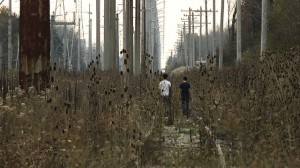
Still from Madsen Minax’s film “The Year I Broke My Voice” (2012) (all images courtesy the artist via BrokeVoiceFilm.com)
CHICAGO — Somewhere in a Neverland-type realm located outside of an urban center, gender-ambiguous characters roam free, constructing their own sexualities, identities, social rules and families. Far from any sort of utopia, a concept that has been popular in queer theory circles and is perhaps best known by Jose Esteban Muñoz’s 2009 textCruising Utopias: The Then and There of Queer Futurity, the world portrayed in Madsen Minax’s film The Year I Broke My Voice incorporates select scenes and moments from 1980s coming-of-age films such as Stand By Me, The Outsiders and The Year My Voice Broke. It expands and plays with the social construction of adolescence through a cast of characters that have agency and knowingness about the world around them. This sort of sideways growth emphasizes notions of perpetually “becoming” rather than a linear model of growing up. The characters in Minax’s film defy notions of adolescence as a time of confusion and irresponsibility. Here’s a closer look into Madsen’s fascinating film, The Year My Voice Broke.
Alicia Eler: How did the story come to you? What were your inspirations for the film?
Madsen Minax: In addition to the three coming of age films from which the script is directly appropriating, I watch a LOT of science fiction and fantasy films, and am sort of obsessed with the idea of the reenactment, the nostalgias it triggers, and the idea of having a re-do in the face of the idea that you can never go home, there is no home. Those two ideas are at odds with one another. Also I’m pretty disinterested in visualizing utopias, which have been a queer hot point for the last 10 years it seems. Heterotopias (or perhaps homotopias!) and dystopias are of more interest to me.
AE: Where did you shoot the film? Were you in Gary, Indiana? Tell me a bit about why you chose the location you did.
MM: A lot of the more iconic images in this film were shot in Gary, and some surrounding towns, like Whiting. However most of the interior scenes were shot at different locations around Chicago, some in Evanston in a building I had access to, some in the basement of my apartment building in Rogers Park, and some of the exterior shots took place on the North side, near New Trier High School. I was predominantly searching for sites that felt kind of a-temporal, or places that seemed to have been forgotten by time. Science fiction, dystopias, industrial wastelands, etc. . . had a lot to do with my choices regarding location.
Read the full interview on Hyperallergic: http://hyperallergic.com/79864/queer-becomings-in-a-dystopian-world/



